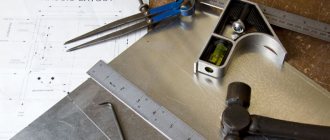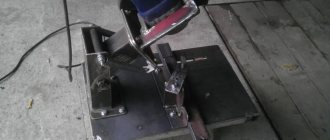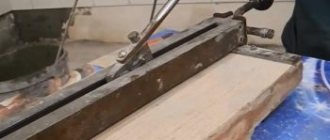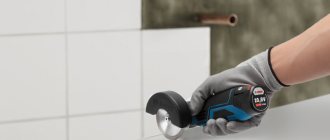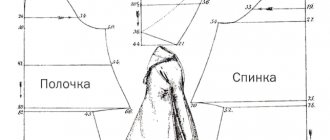The polishing process is carried out upon completion of many works. This is a rather labor-intensive and time-consuming technology. Doing it manually requires a lot of patience. In addition, to obtain a high-quality result, you must have at least some experience and skills.
For example, after painting a car, final polishing is carried out. After the cutters are completed, they are sharpened. A felt wheel for sharpening is a good assistant in these matters. But, without knowing the technology, you can ruin the previously done work. Let's try to understand all the features.
DIY felt circle for sharpening
The polishing process is carried out upon completion of many works.
This is a rather labor-intensive and time-consuming technology. Doing it manually requires a lot of patience. In addition, to obtain a high-quality result, you must have at least some experience and skills. For example, after painting a car, final polishing is carried out. After the cutters are completed, they are sharpened. A felt wheel for sharpening is a good assistant in these matters. But, without knowing the technology, you can ruin the previously done work. Let's try to understand all the features.
Body polishing
The polishing process can correct only some defects. If there is corrosion, chips or damage on the body through which the steel frame is visible, then a major repair will be required.
Before starting the polishing process, you should carefully inspect the vehicle to ensure that any imperfections can be eliminated.
Treatment of the body with a special device will give a positive result if:
- slight difference in shades that resulted after partial coloring;
- the presence of roughness, scratches and cloudy stains;
- faded layer of paint;
- the appearance of graininess and streaks of enamel.
You need to know that you can’t overuse polishing, because when you do it, the paint layer becomes smaller by 5 micrometers. From the date of manufacture of the vehicle, no more than 20 polishing procedures can be performed. At this time, you need to use a thickness gauge, especially if the car is used.
A little about the material
As noted above, an indispensable assistant in the polishing business is a felt polishing wheel.
Most often, circles are made from well-pressed, high-quality wool. This is a fairly effective method of grinding, which is ensured due to the protein nature of the material used. Wool fibers are rich in a substance called keratin. It is characterized by the enrichment of basic carboxyl and amino groups. It is thanks to this that the possibility of chemical interaction with various components of the processed material is ensured. During the process, various suspensions or pastes can be used to enhance the polishing effect.
The protein origin of the material increases grinding efficiency, which is not achieved when using non-protein polishing materials.
DIY abrasive wheel.
First, I’ll briefly go through the points, if you don’t change your mind, then I’ll write in detail. I'm afraid I won't manage this evening 
1. Circle - cylinder Approximately f200 x 30 width - maximum. I plan to add a profile later - this is how it is always done.
Yeah that's good. The straight profile is the easiest to manufacture.
that's good. The straight profile is the easiest to manufacture.
Press form. For small volumes, the mold undergoes maintenance for at least 45 units. In case of increasing the volume of the mold, it is advisable to chrome plate it followed by grinding. The durability of the chrome plated mold is approximately 150-200 pressings.
2. I planned to try regular garnet sand, which is sold for sandblasting. In our area it’s not so easy to buy what you need, and it’s cheap.
You need to be careful with the components. If you want to have a predictable result, then it is better to work on one or two types of abrasive. Preferably a factory-made abrasive with the required dispersion and constant chemical composition (a quality certificate is desirable, but not required). It is better to refrain from abrasive, which is shoveled into bags in a nearby quarry. Using the correct basic components (abrasive and bond) will prevent damage to nerve cells in the future. 
3. I don't know. That's why I created the topic. I was thinking of trying some kind of glue - if they suggest, or a polymer melt. The bond should be soft, sand that wood (also soft)
This is ambiguous. The main requirement for the bond is to “correctly” hold the abrasive. Grinding occurs due to wear of the abrasive, and not due to the bond. The bond can enhance or weaken the effect of the abrasive. For example, a tool on ceramics and FFS. The characteristics of the tool are the same. But after grinding with a tool based on FFS, the surface will be cleaner, because... The resin has a slight polishing effect.
I tried an ordinary stone with silicon carbide - green - so it started instantly - and that’s it (((.
Most likely, the circle was solid with low porosity
4. There is a press, What is a thermostat in relation to the situation? Something to heat and control - I have... - a set of heaters of different shapes and an Aries controller for them.
When using a binder that does not require heating (epoxy resin, liquid glass), the question of a thermostat disappears by itself. When using binders made of thermoplastics and thermosets, you will need a stove that allows you to reach a temperature of 200 ° C. When using phenol-formaldehyde resins (bakelite, FFS), the accuracy of maintaining temperature throughout the entire volume of the oven should be plus or minus 2-3 degrees. When using thermosets (FFS), a finished unreinforced circle can be obtained, as a rule, in two ways: cold pressing and hot pressing. In the first case, a sample of the mechanical mixture of components is loaded into a mold and pressed. The workpiece is removed from the mold and placed in an oven for curing. In the second case, a sample of the mixture is loaded into a mold and pressed on a press equipped with heating plates. After a certain time, the finished product is removed from the mold. Having tried hot pressing, I almost immediately abandoned it and completely switched to cold pressing.
5. I have never heard of domestic circles for this purpose, and GOST for them. Imported ones have their own markings, which do not carry any meaning for me like CL CLR CB CS.
Anyway. If there were some initial data, it would be possible to immediately narrow down the search and development circle. But even so you can make some kind of technical specification for yourself. 
6. 5-10 laps every month. Impossible to say as longevity is unknown.
Before starting the conversation here, I talked with sellers of such products. It's difficult to get a clear answer. You need to try and try.
If you seriously want to make circles, then it will take some time to perfect the technology.
What fibers are used
Felt, which is used for polishing wheels, is divided into the following types according to its composition: fluff, awn, transitional hair and dead hair. Down felt contains fibers with the highest elasticity and has the largest number of flakes. The highest degree of coarseness is present in dead hair; here elasticity indicators are completely absent.
Some main composition characteristics are provided in the table.
| Name of felts | Fiber content percentage | |||
| Pooh | Transitional hair | Ost | Dead hair | |
| Fine-haired | 0,9 | 0,5 | 0,05 | — |
| Semi-coarse-haired | 0,3 | 0,3 | 0,35 | 0,05 |
Types of circles
The felt polishing wheel is divided into several types according to the percentage composition of fibers:
- fine-haired;
- semi-coarse-haired;
- rough-haired.
The best polishing wheels are obtained with higher density felts as they are more resistant to wear. Other types quickly become unusable. But it should be noted that their use when grinding, for example, the surface of a car is not permissible. The best in this direction are fine-wool felt circles. They are also good for polishing products made of non-ferrous metals or aluminum.
As for semi-coarse wool products, their area of application is mainly aimed at sharpening delicate instruments. For example, surgical scalpels, parts for precision measuring instruments, etc.
Features of the technology for using felt discs
Ensuring high-quality execution of the process is determined by the speed of rotation of the felt disk. The best option is if the machine develops a rotation speed of 5 – 10 m/s. Otherwise, the following problems arise:
- artificial hardening of the treated surface occurs, it becomes harder and less amenable to grinding or sharpening;
- When the rotation speed increases, polishing fibers are torn off the surface of the wheel under the influence of centrifugal forces, and the material is wasted.
The entire list of available felt circles
| № | Name | List of sizes, cm | Density degree |
| 1 | Coarse wool felt circles | 10-2-3,2 12,5-2-3,2 15-2-3,2 20-2-3,2 20-2,5-3,2 20-4-3,2 | 0.30-0.45 g/cm 3 |
| 2 | Semi-coarse felt circles | 12,5-0,8-2,2 12,5-2-2 12,5-2-3,2 15-2-3,2 20-2-3,2 20-2,5-3,2 20-4-3,2 | 0.33-0.48 g/cm 3 |
| 3 | Fine wool felt circles | 12,5-2-3,2 15-2-3,2 20-2-3,2 20-2,5-3,2 20-4-3,2 | 0.38-0.50 g/cm 3 |
DIY felt disc
If desired, you can prepare a grinding wheel at home with your own hands from felt or felt material. For example, if there are old felt boots in the house, then from their tops you can cut out circles of the required diameter. Typically, the diametrical section size varies from 50 mm to 250 mm.
Discs with a diameter of 200 mm are in particular demand. It depends on the area of its application and the technical characteristics of the machine. The thickness of the discs should be from 30 mm to 50 mm. Although this is not mandatory. The number of blanks depends on the size of the future disk.
Sequencing
Next we perform the steps in the following order:
- We pay special attention to the technology of gluing workpieces. They need to be lubricated with glue, but the adhesive composition cannot be brought to the edges, since when it dries, abrasive particles may form. During polishing they can damage the surface;
- After all the layers are coated, we connect them to each other and press them with a weight until the glue dries completely;
- After this, a hole of the appropriate diameter is drilled in the center of the resulting disk;
- Next, install the disk on the sharpening machine and clamp it with two nuts. The rigidity of the disk installation is ensured by washers, but it should be remembered that their diameter should not exceed a third of the diametrical section of the disk;
- In order to make the circle removable, you can fix a small rod in its hole. In this case, it can be mounted on a drill.
Video
Making your own nozzles
If there is no suitable option on sale, then for a disk with a high level of rigidity you can make a soft layer of great thickness and place it between Velcro and a plastic base. Using a utility knife, you need to cut off the Velcro where the soft layer will be glued. For the soft layer, a bath sponge is mainly used. It must be remembered that individual elements can shift, breaking the overall symmetry.
You can also use a felt disc, which is used in a polishing machine and machine. First, you should make a pin with a suitable diametrical size and apply a thread on one side. On this side you need to secure the disk, which is surrounded on both sides by a wide nut and a limit washer. This device is not difficult to manufacture and can be used to process various surfaces.
How to make a felt circle from felt boots and plywood
A felt circle for polishing metal can be made from felt boots and pieces of plywood. Moreover, a homemade felt circle is quite universal. It can be installed either on an emery machine or on an angle grinder.
To begin with, the author cuts out a square of the required size from a sheet of plywood. Then he marks the center and drills a hole in it for an M8 bolt. And then you need to draw a circle and use a jigsaw to cut out a round workpiece.
The edges of the workpiece must be sanded so that they are smooth. Then you will need to cut out another circle from plywood using a ready-made template. The blanks need to be glued together.
Manufacturing of grinding discs for bur machines
Also, in addition to angle grinders, we quite often use a drill with small cutting discs, but the quality of such small discs is very poor, they break even from the slightest blow, so you can make such small discs from a broken large one. Just apply a small disk, trace it, cut it out with metal scissors, make a hole in the center and you can use it.
From one broken disk you can get up to 10 small pieces, depending on the size and quality and strength they will be much better. These discs can be used to saw off fairly thick metal and will wear out less.I also advise you to look at the video on this topic:
Well, that’s all for me, I hope this post was useful. If you still know any methods or ideas on this topic, write in the comments, it will be interesting to read. Thank you all very much for your attention and see you new homemade products!
How to make a felt circle for a small grinder
In a private home, garage or workshop, a felt wheel is usually used for polishing axes and knives. In general, the thing is necessary and useful, and you don’t have to buy it.
You can make a felt circle for a small grinder with your own hands. And this is not at all difficult, as it might seem at first glance.
As a basis, the author uses a disc with Velcro for grinding wheels, which goes on an angle grinder. First of all, it is necessary to completely remove the material with Velcro - only “bare” plastic and a nut for the angle grinder should remain.
Types of grinding wheels
Sanding attachments can be classified as a peeling material. They are discs whose edges have iron wire. Cleaning wheels are used to remove corrosion from the metal surface, as well as to remove other types of contaminants. In 80% of cases they are used to prepare pipes for painting.
There are four types of grinding disks, but the most popular of all types of grinding devices is the flap disk. Sanding wheels for an angle grinder are usually used to remove old varnish or paint, as well as to sand the surface of wood. This product is used for grinding parts made of metal, plastic and wood. An emery circle is a circle with small pieces of sandpaper fixed along the edge. Taking into account the type of work, you should choose the size of the abrasive grains of the working element.
The use of a petal-type disk makes it possible to pre-process a product made of different materials. It is permissible to perform finishing processing with it. For final grinding, use discs with a fine grain size.
On sale you can find the following types of petal circle:
- Batch.
- Tortsevoy.
- Equipped with mandrel.
A grinding disc for an angle grinder with a mandrel is used if high-precision work is required. Most models that belong to this category are used to remove burrs after cutting metal or plastic pipes. The finishing grinding of the weld seam is carried out using a grinding disc. The components of the circles include carborundum or electrorundum chips. The structure of the circle also contains fiberglass mesh. These wheels are much thicker than cutting wheels for metal.
There are many metal brush attachments to choose from for sanding work:
- To clean the surface from stubborn dirt or corrosion (wire discs).
- Diamond cups are needed to polish stones.
- For polishing metal, disc-shaped nozzles made of rubber/plastic, to which an abrasive mesh/emery cloth is attached, are excellent.
But let's learn how to make a sanding and polishing disc yourself.
Main stages of work
You need to glue a piece of felt to the disk. Then you need to cut it evenly along the contour of the disk and carefully trim the edges. In this case, the master uses superglue.
After the glue has set (it is advisable to wait about 4-5 minutes), you need to cut the felt in a circle with scissors. The edge of the circle is smoothed on sandpaper.
The felt circle is now ready to use. To do this, you need to fix the part that needs to be polished in a vice (or press it against the table with a clamp), apply GOI paste or another polishing paste to the wheel, and you can start working.
For details on how to make a felt circle for a small grinder with your own hands, watch the video on the website.
Source
How to make polishing wheels on sandpaper with your own hands
In this review, the master shows how you can make polishing wheels on sandpaper with your own hands. These wheels are perfect for rough polishing of various metal products. At the same time, making them is as easy as shelling pears.
In most cases, a set of two polishing wheels will be sufficient for a home workshop. The master makes the first circle from what was at hand - these are the tops of old felt boots (material - coarse wool).
To make a second polishing wheel for emery, felt is also used, but of medium hardness. First of all, the master cuts circles of the required diameter from felt. You need to make holes in the center with a punch.
What are metal grinding discs?
Sanding is one of the most popular processes for which a grinder is used. Using this device and a set of attachments, you can carry out both rough and gentle processing of metal, stone and wooden surfaces. Basically, grinding is carried out before polishing the product. The attachments used in this case may contain felt material or even sandpaper.
For grinding metal products, different brushes are used, which are made from wire, which is located on a metal base. Moreover, now it is even possible to buy other, more technological attachments for an angle grinder. The tape file will be direct proof of this. It is used for grinding, polishing and removing traces of corrosion. Taking into account the required surface quality, you can mount wheels on an angle grinder that have replaceable sandpaper, as well as porous, felt and even fabric wheels.
Please note that the angle grinder must have smooth speed control, which will be a prerequisite for using such an attachment.
Grinding wheels for metal are used to perform the following activities:
Sharpening tools.- Final processing of welding seams.
- Cleaning the surface from corrosion and paint.
In most cases, the work will require special abrasive pastes, and sometimes even special liquids. For rough grinding and cleaning, grinding discs with small abrasive chips are used. Grinding wheels for grinders make it possible to process material to the desired degree of roughness. For example, such nozzles are even used for car service to polish the car body.
Main stages of work
First, the master makes the first polishing wheel - from coarse wool (felt boots). In total you will need four blanks for it. They need to be glued together, clamped with a clamp and left until the glue dries completely.
The second polishing wheel is made from medium-hard felt in the same way. Additionally, you will need to find or make your own round pressure plates from metal or plywood.
Then the master places both circles on the emery shaft and processes the edges with a rasp. After this, you can begin rough polishing of parts and workpieces.
You can watch the video on our website for details on how to make polishing wheels on sandpaper with your own hands.


